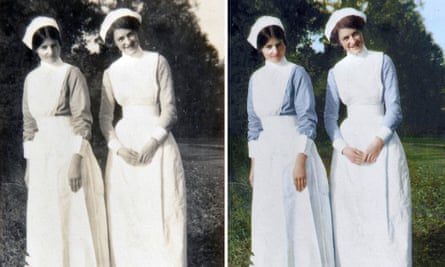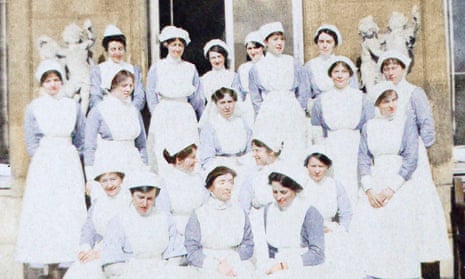English Heritage has appealed for public help to trace the identities of more than 100 nurses from the first world war who have fallen through the gaps of history but deserve recognition as “the backbone of the war effort”.
The charity has colourised rarely seen archive photos in the hope that people may be able to spot their ancestors. All the nurses worked in Wrest Park in Bedfordshire, England’s first wartime country-house hospital.
Andrew Hann, a historian at English Heritage, said a lot of excellent research had been done by volunteers about Wrest Park’s history as a military hospital. But they had hit a brick wall when it came to the staff.
“These women were the backbone of the hospital, and indeed the war effort, providing much needed treatment to the wounded, but also acting as a comfort to those soldiers traumatised by the horrors of war,” said Hann. “They worked tirelessly and deserve to be known as individuals, just as the soldiers they cared for do.”
He said identifying the nurses would help the team better understand life at Wrest Park during the war.
“We are interested in the human stories that are hinted at from the photographic evidence we have. Women played a vital role in supporting the war effort at home, not least as auxiliary nurses in country-house hospitals such as Wrest Park, and we are keen to celebrate their efforts and achievements,” he said.
“It would be wonderful if the public could help us identify these forgotten women.”
Wrest Park was offered to the nation by its owner, Auberon Herbert, the ninth Baron Lucas, as a place to treat wounded servicemen. It functioned as an auxiliary hospital for two years until it was forced to close in 1916 after a fire.

Marina Amaral, the digital colourist involved in the project, said: “To see images in colour is to see the real people behind the photographs.
“Humans live in colour, and this helps us see people from a more personal perspective – they are no longer removed from reality, but real people with lives and purpose. These women did remarkable jobs during the first world war and if my coloured images help people recognise their family members then that would be an amazing outcome.”
There were up to 24 nurses at any one time in the house, cleaning wards, making beds, changing dressings and tending to between 150-200 soldiers recovering there.
The coloured photographs will be on display at Wrest Park, which English Heritage looks after, from Saturday until the end of the month.
Anyone who recognises someone is asked to email Wrest Park’s volunteer history team at wresthistoryvolunteers@english-heritage.org.uk.
